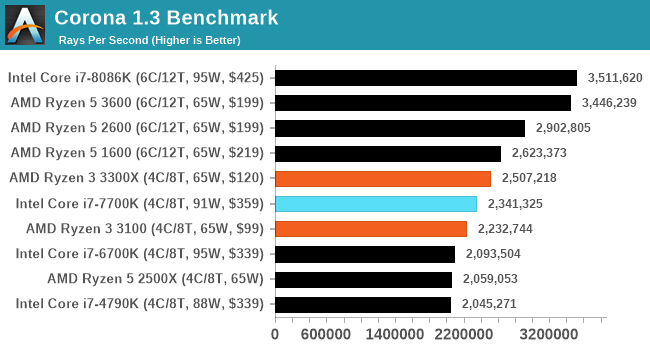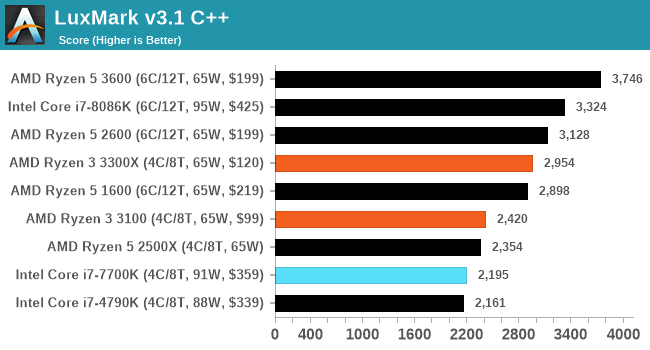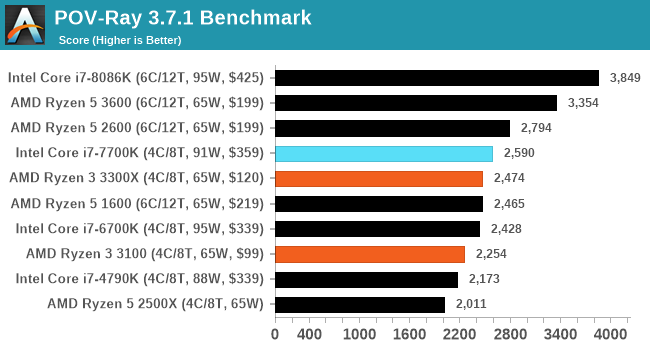The AMD Ryzen 3 3300X and 3100 CPU Review: A Budget Gaming Bonanza
by Dr. Ian Cutress on May 7, 2020 9:00 AM ESTCPU Performance: Rendering Tests
Rendering is often a key target for processor workloads, lending itself to a professional environment. It comes in different formats as well, from 3D rendering through rasterization, such as games, or by ray tracing, and invokes the ability of the software to manage meshes, textures, collisions, aliasing, physics (in animations), and discarding unnecessary work. Most renderers offer CPU code paths, while a few use GPUs and select environments use FPGAs or dedicated ASICs. For big studios however, CPUs are still the hardware of choice.
All of our benchmark results can also be found in our benchmark engine, Bench.
Corona 1.3: Performance Render
An advanced performance based renderer for software such as 3ds Max and Cinema 4D, the Corona benchmark renders a generated scene as a standard under its 1.3 software version. Normally the GUI implementation of the benchmark shows the scene being built, and allows the user to upload the result as a ‘time to complete’.
We got in contact with the developer who gave us a command line version of the benchmark that does a direct output of results. Rather than reporting time, we report the average number of rays per second across six runs, as the performance scaling of a result per unit time is typically visually easier to understand.
The Corona benchmark website can be found at https://corona-renderer.com/benchmark

LuxMark v3.1: LuxRender via Different Code Paths
As stated at the top, there are many different ways to process rendering data: CPU, GPU, Accelerator, and others. On top of that, there are many frameworks and APIs in which to program, depending on how the software will be used. LuxMark, a benchmark developed using the LuxRender engine, offers several different scenes and APIs.
In our test, we run the simple ‘Ball’ scene on both the C++ and OpenCL code paths, but in CPU mode. This scene starts with a rough render and slowly improves the quality over two minutes, giving a final result in what is essentially an average ‘kilorays per second’.

POV-Ray 3.7.1: Ray Tracing
The Persistence of Vision ray tracing engine is another well-known benchmarking tool, which was in a state of relative hibernation until AMD released its Zen processors, to which suddenly both Intel and AMD were submitting code to the main branch of the open source project. For our test, we use the built-in benchmark for all-cores, called from the command line.
POV-Ray can be downloaded from http://www.povray.org/












249 Comments
View All Comments
PeterCollier - Saturday, May 9, 2020 - link
Where are the AMD APUs?PeterCollier - Friday, May 8, 2020 - link
0The_Assimilator - Thursday, May 7, 2020 - link
Please shut up.b0rnslippy - Thursday, May 7, 2020 - link
Why? not all of them are blind Ian supporters. Just saying it like we seeing it.Teckk - Thursday, May 7, 2020 - link
You think this article is biased towards Intel?mrvco - Friday, May 8, 2020 - link
The narrative seems forced in lieue of current and price competitive offerings from Intel. Hard to blame AT though, must publish. Regardless, AMD is absolutely ballin'.brunis.dk - Saturday, May 9, 2020 - link
Unbelievable.. this chip is a quarter of the price and is a fucking steel and totally embarrasses Intel's best .. and he thinks its Intel biased, what the actual F?Spunjji - Monday, May 11, 2020 - link
Yeah, this "logic" isn't working out at all.I'm hard pressed to tell whether these comments are from actual dyed-in-the-wool AMD fanboys or a few Intel nuggets doing their best impersonations of how they think one would behave. 🤔
PeterCollier - Monday, May 11, 2020 - link
Socrates said it's the mark of an informed mind to entertain a thought without rejecting it.It's the mark of an uninformed mind to be unable to entertain an opposing viewpoint and instead dismiss it as trolling.
FreckledTrout - Monday, May 11, 2020 - link
Those trolls in 400BC were a pain writting stuff in stone and all.